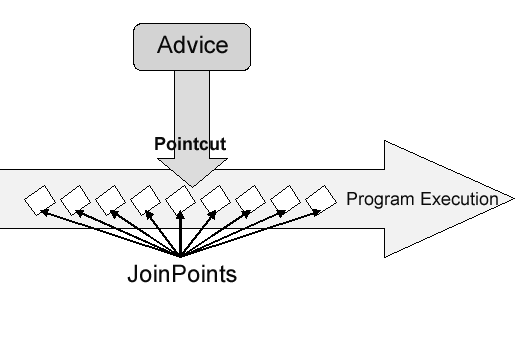AOP
A programming paradigm that enables the management of common functionalities (cross-cutting concerns) separate from the core business logic, by modularizing them into an “Aspect.”
- Core concept here is Separation of Concerns
- Applying AOP allows defining common functionalities in one place, automatically “woven” into the necessary core logic
- Limitations of OOP
- OOP separates responsibilities by roles (classes/modules).
- Repetitive logic like logging, security, transactions, and timing often appears across modules. This logic gets scattered and duplicated.
- OOP struggles to eliminate such cross-cutting concerns cleanly
- Cross-Cutting Concerns
- functionalities that are not directly related to business logic but appear repetitively across multiple layers or components ⇒ AOP reduces this
- Examples
- Transaction (very good w/ AOP)
- Logging
- Security
- Checking performance
Example
Before AOP
@Service
public class MemberService {
private final MemberRepository memberRepository;
public MemberService(MemberRepository memberRepository) {
this.memberRepository = memberRepository;
}
public void join(Member member) {
long start = System.currentTimeMillis(); // Non-core logic
try {
// Core Logic
memberRepository.save(member);
} finally {
long end = System.currentTimeMillis(); // Non-core logic
long time = end - start;
System.out.println("MemberService.join execution time = " + time + "ms"); // Non-core logic
}
}
}- Core logic and supplementary logic are mixed within a single source code file.
- The
join()method contains execution time measurement code mixed with its core logic (saving a member). - If this logic is repeated across multiple methods or classes, it increases duplication, making maintenance difficult.
After AOP
// Core Logic Class
@Service
public class MemberService {
private final MemberRepository memberRepository;
public MemberService(MemberRepository memberRepository) {
this.memberRepository = memberRepository;
}
public void join(Member member) {
memberRepository.save(member); // Pure core logic
}
}
// Common functionality (here, logging execution time) separated
@Aspect // Marks this class as an Aspect
@Component // Registers this Aspect as a Spring Component/Bean
public class TimeTraceAspect {
// Specifies where this advice should be applied (all methods in 'com.example' and its sub-packages)
@Around("execution(* com.example..*(..))")
public Object trace(ProceedingJoinPoint joinPoint) throws Throwable {
long start = System.currentTimeMillis(); // Common functionality
try {
return joinPoint.proceed(); // Executes the actual target method
} finally {
long end = System.currentTimeMillis(); // Common functionality
long time = end - start;
System.out.println("[Execution Time] " + joinPoint.getSignature() + " = " + time + "ms"); // Common functionality
}
}
}- Core logic and supplementary logic can be completely separated.
- Common functionalities are managed in one place, greatly improving maintainability and extensibility.
AOP in Spring
Summary
Spring supports
@AspectJstyle AOP and primarily provides proxy-based AOP from the full AspectJ capabilities.
- Advice
- Supplementary functionalities (e.g., start the timer)
- Proxy-based AOP implementation
- It creates and provides a proxy for the target object.
- At runtime, Spring creates a proxy object that wraps the target object (e.g., your
MemberService). - When a method on the proxy is called, the proxy can execute the advice before or after delegating the call to the original target object.
- Method Join Points Only
- Advice can only be applied at runtime when the core functionality’s (target object’s) method is called.
Key Components

| Term | Description |
|---|---|
| Aspect | A module that defines a cross-cutting concern. - In Spring, this is typically a separate class annotated with @Aspect.- It contains both the Advice (the “what”) and the Pointcut (the “where”).- E.g., logging, transactions. |
| Join Point | An execution point in your code where the Advice could be applied - In Spring AOP, this is always the execution of a method - e.g., the exact moment memberService.join() is called |
| Advice | The actual code that is executed for the cross-cutting concern - The specific code for the extra action (e.g., logging, printing, security, etc. - Also says when to do it (e.g., @Around the method).- E.g., @Before, @After, @Around, @AfterReturning, @AfterThrowing. |
| Pointcut | An expression that selects the Join Points where the Advice should be applied. - Acts as a filter. - E.g., execution(* com.example..*(..)) is a pointcut that matches all method executions in the com.example package and its sub-packages. |
| Weaving | The process of linking the Aspect with the target object to create the final proxied object. - In Spring AOP, weaving happens at runtime when the application starts. |
- 꼭 알아야할것
- aspect
- join point
- advice
- pointcut